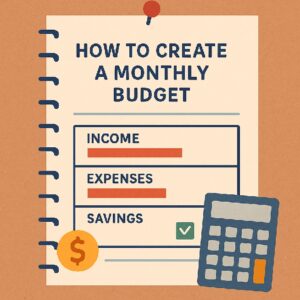How to Create a Monthly Budget:
Take Control of Your Finances One Month at a Time

“A budget is telling your money where to go instead of wondering where it went.”
— John C. Maxwell
Have you ever reached the end of the month and wondered where all your money went?
You’re not alone.
For many people, managing money feels overwhelming or confusing. But creating a monthly budget — and sticking to it — is one of the most empowering things you can do for your financial well-being.
A budget helps you:
- Understand your income and expenses
- Reduce financial stress
- Reach your savings goals
- Avoid debt
- Align your spending with what matters most to you
And here’s the good news: creating a monthly budget doesn’t have to be complicated. Whether you’re budgeting for the first time or refining your process, this guide will walk you through step by step.
Why Budgeting Matters
Provides Clarity and Control
When you know exactly how much money is coming in and going out, you gain control over your finances. No more surprises.
Reduces Stress
A budget gives you peace of mind. You’ll stop worrying about whether you can pay bills or afford a purchase — you’ll already know.
Helps Achieve Goals
Whether you want to pay off debt, save for a vacation, or build an emergency fund, a budget helps turn your goals into reality.
Encourages Mindful Spending
Budgeting encourages you to spend intentionally, not impulsively.
Common Myths About Budgeting
“Budgeting is restrictive.”
Actually, a good budget gives you freedom. You decide where your money goes.
“I’m not good with numbers.”
You don’t need to be. Simple tools — even a notebook or free app — can help.
“I don’t make enough to budget.”
Budgeting is important for everyone, regardless of income level.
Step-by-Step: How to Create a Monthly Budget
Step 1: Determine Your Monthly Income
Start by knowing exactly how much money you have to work with. Include:
- Salary (after taxes)
- Freelance income
- Side hustle earnings
- Rental income
- Any other consistent income sources
If your income varies, take an average of the past 3–6 months or budget based on your lowest expected income.
Tip: Always budget using net income (after taxes), not gross income.
Step 2: Track Your Expenses
Before you can plan where your money should go, you need to understand where it’s currently going.
Track your expenses for at least one month.
Use your bank statements, receipts, or a budgeting app to review spending in categories such as:
- Rent or mortgage
- Utilities (electricity, water, internet, etc.)
- Groceries
- Dining out
- Transportation (gas, public transit, car maintenance)
- Insurance
- Subscriptions
- Entertainment
- Clothing
- Debt payments
- Savings contributions
This will give you a clear picture of your spending patterns.
Step 3: Categorize Your Expenses
Next, organize your expenses into categories:
- Fixed expenses: same amount each month (rent, car payment)
- Variable expenses: fluctuate month to month (groceries, entertainment)
- Discretionary expenses: optional spending (shopping, hobbies)
- Savings and debt repayment: contributions toward financial goals
Knowing your categories will help you prioritize and adjust spending as needed.
Step 4: Set Spending Limits
Now that you know your income and spending patterns, it’s time to set intentional spending limits.
Start with essentials:
- Housing: generally aim to keep this under 30% of your income.
- Utilities and transportation: budget realistically based on past trends.
- Groceries: find a balance that works for your household size and preferences.
Then allocate funds for:
- Debt repayment (if applicable)
- Savings (aim for at least 20% of your income if possible)
- Discretionary spending (fun money!)
Your goal is to ensure your total planned expenses do not exceed your income.
Tip: Build in some buffer space for unexpected costs.
Step 5: Choose a Budgeting Method
There are several effective budgeting methods. Choose one that fits your style:
The 50/30/20 Rule
- 50% needs (housing, groceries, transportation)
- 30% wants (entertainment, hobbies)
- 20% savings and debt repayment
Zero-Based Budget
- Every dollar of income is assigned a purpose until your budget equals zero.
Envelope System (for cash users)
- Allocate cash for different categories and only spend from those envelopes.
Pay-Yourself-First
- Prioritize savings first, then allocate the remainder for spending.
Step 6: Use Tools to Manage Your Budget
You can budget with:
- A simple spreadsheet
- A budgeting notebook
- Free apps (Mint, Goodbudget, EveryDollar)
- Paid tools (YNAB — You Need a Budget)
Choose a system you’ll actually use consistently.
Step 7: Monitor and Adjust Regularly
Budgeting isn’t a “set it and forget it” task. Life changes — so should your budget.
- Review weekly: Track spending and make adjustments.
- Reflect monthly: What worked? Where did you overspend? What can you improve?
- Update for changes: Income increase? New expense? Adjust accordingly.
Remember: A budget is a living document. Flexibility is key.
Budgeting for Special Situations
Irregular Income
If your income varies, base your budget on your lowest monthly income. Save extra income in high-earning months to cover leaner ones.
Paying Off Debt
Prioritize debt repayment in your budget. Consider using the Debt Snowball or Debt Avalanche method.
Building an Emergency Fund
Budget for small, regular contributions. Aim for 3–6 months’ worth of expenses.
Saving for Big Goals
Break large goals (vacation, home purchase) into monthly savings targets. Add them as line items in your budget.
Tips for Long-Term Budgeting Success
1. Start Simple
Don’t overcomplicate it. The best budget is one you can stick to.
2. Build in Fun
Allow room for enjoyable spending. Deprivation leads to burnout.
3. Celebrate Wins
Paid off a credit card? Met your savings goal? Celebrate progress.
4. Involve Your Family
If you share finances, budget together. Transparency promotes teamwork.
5. Be Patient
It takes time to build new habits. Stick with it — your future self will thank you.
Common Budgeting Mistakes to Avoid
- Being too rigid: Leave some room for flexibility.
- Ignoring irregular expenses: Plan for annual fees, gifts, and maintenance.
- Not reviewing regularly: Frequent check-ins help keep you on track.
- Comparing your budget to others’: Your financial journey is unique.
Final Thoughts
Creating a monthly budget is one of the most powerful tools you have to take control of your financial life. It’s not about restriction — it’s about alignment.
When you budget, you tell your money where to go, ensuring it supports the life you want to live.
Start today:
- Calculate your income.
- Track your expenses.
- Set spending limits.
- Monitor and adjust.
Remember: perfection isn’t the goal — consistency is. Over time, you’ll build habits that empower your financial freedom.
Here’s to budgeting smarter and living better — one month at a time.
#budgeting #monthly budget #personal finance #money management #saving money #financial goals #debt repayment #budgeting tips #how to budget #money planning
Why ETFs Are the Future of Wealth Building – A Complete Guide

